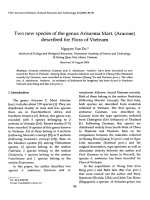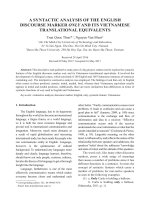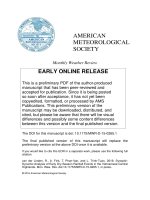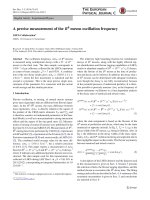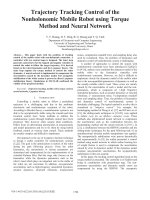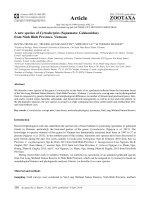DSpace at VNU: A syntactic analysis of the English discourse marker only and its Vietnamese translational equivalents
Bạn đang xem bản rút gọn của tài liệu. Xem và tải ngay bản đầy đủ của tài liệu tại đây (342.29 KB, 11 trang )
A SYNTACTIC ANALYSIS OF THE ENGLISH
DISCOURSE MARKER ONLY AND ITS VIETNAMESE
TRANSLATIONAL EQUIVALENTS
Tran Quoc Thao*,1, Nguyen Van Muoi2
Ho Chi Minh City University of Technology and Education,
01 Vo Van Ngan, Thu Duc, Ho Chi Minh City, Vietnam
2
Buon Ma Thuot University, 298 Ha Huy Tap, Tan An, Buon Ma Thuot, Vietnam
1
Received 28 April 2016
Revised 09 May 2017; Accepted 16 May 2017
Abstract: This descriptive and qualitative study, part of a big project, endeavored to explore the syntactic
features of the English discourse marker only and its Vietnamese translational equivalents. It involved the
development of a bilingual corpus, which consisted of 168 English and 168 Vietnamese instances of sentences
containing only. The interpretive contrastive analysis was employed. The findings reveal that only in English
often comes in three positions, namely, initial, medial, final, whereas their Vietnamese equivalent usually
appears in initial and medial positions. Additionally, there are more similarities than differences in terms of
syntactic functions of only used in English and Vietnamese.
Keywords: contrastive analysis, discourse marker, English, only, syntactic feature, Vietnamese
1. Introduction
The English language, due to its hegemony
throughout the world, has become an international
language, a lingua franca, or a world language,
so it is both the most common language and
pivotal tool in international communication and
integration. Moreover, much more demand, as
a result of rapid globalization and increasing
international trade, has been made for people who
can communicate orally in English. Language,
however, is the quintessence of cultural
background. To understand any languages more
deeply and clearly, language learners, therefore,
should know not only people, customs, cultures,
but also the theory of its language to get a thorough
insight into the language.
Language, furthermore, is one of the most
effectively communicative means which makes
everyone become closer and understand each
* Corresponding author. Tel.: 84-989637678
Email:
other better. “Faulty communication causes most
problems. It leads to confusion and can cause a
good plan to fail” (Junarso, 2009, p. 100) since
communication is the exchange and flow of
information and idea to a receiver. “Effective
communication occurs only if the receiver
understands the exact information or idea that the
sender intended to transmit” (Cochrane & Pierce,
1988, p. 95). Linguistic meaning, on the other
hand, is influenced by and reflects the nature of the
relationship between speakers and addresses, the
speakers’ belief about the addresses’ knowledge
and state of mind, and the attitude of the speakers.
The word only, like many other discourse
markers, poses a wide range of meanings
that causes a number of problems since it has
different functions in a sentence. It raises the
concept of syntactic features which cause a
number of problems for non-native speakers
as seen in the following examples:
(1) a. Only Carla is holding a balloon.
b. Carla is holding only a balloon.
(Matsuoka, 2011, p. 1)
78
T.Q. Thao, N.V. Muoi / VNU Journal of Foreign Studies, Vol.33, No.3 (2017) 77-87
In (1a) only is employed to premodify
a subject and it means “No other person is
holding a balloon”. Similarly, in (1b) only
premodifies an object. It is explained “Carla is
holding nothing other than a balloon”.
The syntactic position is not always
relevant to the interpretation of focus items.
In the following example:
(2) a. Kazys gave books only to girls.
b. Kazys gave only books to girls.
(Arkadiev, 2010, p. 14)
In (2a), Kazys did not give books to anyone
except the girls, but in (2b) No other things are
given to the girls but books. Clearly, the position
contributes to the interpretation of only, yet it
cannot decide differences in reading. In fact,
the semantic and pragmatic features will reveal
the speaker’s idea or thinking more clearly.
The presence of only in the sentence,
syntactically, may confuse the readers and hearers
because the meaning of the whole sentence
largely depends on its position in the sentence.
Let us observe the sentences as follows:
(3) a. Only Nancy admires her sister.
b. Nancy only admires her sister.
c. Nancy admires only her sister.
d. Nancy admires her only sister.
e. Nancy admires her sister only.
Sentences, from the abovementioned
instances, can be paraphrased differently and
convey different meanings when using only in
different positions in a sentence, so it is not easy
for English learners to use only correctly and
properly because only expresses a variety of
subtly different meanings and its use is subject
to constraints which do not apply to other words
with similar meanings. This paper, hence,
endeavors to study the discourse marker only in
depth in English and in Vietnamese equivalents
in order to explore the syntactic features of only
in English and its Vietnamese equivalents and
their similarities and differences. Two research
questions are formed as follows:
1. What are syntactic features of only in
English and its Vietnamese equivalents?
2. What are their similarities and
differences in terms of syntactic features?
2. Methodology
Corpus
A bilingual corpus comprising 168
English and 168 Vietnamese instances of
sentences containing only sourced from short
stories and modern novels were attained from
different literature books and the websites on
the Internet. Following is table 1 indicating
the corpus for investigation.
Table 1. Bilingual corpus
No
1
2
3
4
5
6
7
8
9
10
11
12
13
14
Corpus
Holiday in the USA
Longman Advanced Grammar
The Jungle Books
The Man of Property
The Moon and Sixpence
The Old Man and The Sea
The Sun also Rises
The Sorrow of War
The Thorn Birds
The International Story
20th Century English Short Stories
20th Century English Short Stories
British National Corpus
An Introduction to Language
Sample analysed
(English)
7
9
5
24
9
18
6
3
7
23
18
10
10
19
Sample analysed
(Vietnamese)
7
9
5
24
9
18
6
3
7
23
18
10
10
19
79
VNU Journal of Foreign Studies, Vol.33, No.3 (2017) 77-87
Research procedure
This contrastive analysis of the discourse
maker only and the Vietnamese translational
equivalents is based on the description of
its meanings in terms of syntactic features.
As regards the data collection, the selected
instances must be English as the source
language and Vietnamese as the target
language, and contain only in English and
instances including the actual translational
equivalents in Vietnamese. The main sources
for collecting data are short stories, modern
novels and online text of chat since they may
provide with reliable samples written by
native writers of English and translated by
Vietnamese.
With respect to data analysis, instances
containing only and its patterns as discourse
markers were classified into meanings and
functions in terms of syntactic forms. The
discourse marker only and its patterns, then,
were qualitatively described and analyzed in
terms of syntactic positions and functions.
Double-check was employed in order
to increase the reliability of the contrastive
analysis. The researchers had two Vietnamese
experts, who were both experienced teachers
of English and translators, as double-checkers
to randomly check three pieces of instances
in English and Vietnamese. The two doublecheckers and researchers had to reach to an
agreement level of reliability (over 85%).
3. Results and discussion
3.1. Positions of only in the sentences and its
Vietnamese equivalents
The discourse marker only can be as a
focusing adverb; however, focusing adverbs
are not normally used at the beginning of a
sentence. The position of only is particularly
flexible, conveying slightly different meanings
according to where it is placed. There are
three main positions for only: initial, medial,
and final positions, which is extremely rare
with any other adverb.
Initial position
The adverb is in the initial position in the
clause with or without juncture, occurring
before the subject or other obligatory elements
of the clause. However, in a limited research,
this study mentions only only, which modifies
not only a noun, a pronoun, but also an adverb
of time. Consider the following sentences:
(4) Only the poet or the saint can water
an asphalt pavement in the confident
anticipation that lilies will reward
his labour. (Junarso, 2009, p.46)
Chỉ có nhà thơ hoặc vị thánh mới có
thể tưới nước trên con đường tráng
nhựa mà dám quả quyết trước là
hoa huệ sẽ thưởng công lao động
của họ. (Nguyễn Thành Thống,
1987, p.70)
(5) But, he thought, I keep them with
precision. Only I have no luck any
more. But who knows? Maybe
today. Every day is a new day.
(Hemingway, 1952, p.24)
Nhưng, lão nghĩ, mình giữ chúng
chính xác. Duy chỉ mình không
còn may mắn nữa thôi. Nhưng
biết đâu được? có thể hôm nay.
Mỗi ngày là một ngày mới. (Lê
Huy Bắc, 1998, p.28)
It is impossible for us to put only in other
positions in above situations. Clearly, when
only is placed in the initial position in English
and its equivalents in Vietnamese, it has its
own meaning, semantic and pragmatic. But
unlike the above examples, only in (6) is in the
initial position in English, while its equivalent
in Vietnamese is placed in a different position
as follows:
(6) “That’s wonderful.” he said sadly,
“wonderful”
80
T.Q. Thao, N.V. Muoi / VNU Journal of Foreign Studies, Vol.33, No.3 (2017) 77-87
“Only he wants me to change the title.”
“Yes?” (Cochrane & Pierce, 1988,
p.239)
“Thật là tuyệt diệu!” “Anh ta nói
buồn bã: “Tuyệt diệu!”
“Ông ta chỉ muốn em đổi tên sách”
“Thế à?” (Mai Khắc Hải & Mai
Khắc Bích, 1994b, p.250)
Medial position
Only, in this situation, is similarly used as
other focusing adverbs. The medial position
can be easily identified after the lexical verb
and in front of other obligatory element of the
clause. For example:
(7) I remember only my own grief
and fright and the shiny path over
father’s head…. (Rooth, 1996, p.83)
Tôi chỉ còn nhớ nỗi đau khổ và lo
sợ và vệt bóng loáng trên đầu bố tôi.
(8) Then he felt the gentle touch on the
line and the happy.
“It was only his turn,” he said. “He’ll
take it”. (Hemingway, 1952, p.34)
Lúc ấy lão cảm thấy sợi dây khẽ
giật, lão hớn hở. “Nó chỉ lượn một
vòng thôi mà”, lão nói. “Nó sẽ cắn
câu.” (Lê Huy Bắc, 1998, p.35)
Final position
It is difficult to find out only in the final
position. Consider the example in (9), only in
this place is employed to modify an object or
complement.
(9) There was just that shadowiness
about them which you find in people
who lives are part of the social
organism, so that they exist in it and
by it only. (Maugham, 1996, p.22)
Bạn sẽ tìm thấy cũng chính điều mù
mờ đó nơi những người mà cuộc
sống là một bộ phận của cơ chế xã
hội, họ chỉ tồn tại được trong đó và
nhờ đó mà thôi. (Nguyễn Thành
Thống, 1987, p. 37)
Table 2. Description of positions of only in
the sentences and its Vietnamese equivalents
No Positions of only
in English
1
Initial position
2 Medial position
3
Final position.
Positions of only in
Vietnamese
Initial and Medial position
Medial position
Medial position
3.2. Syntactic functions of only in the sentences
and its Vietnamese equivalents
As known that the syntactic categories
of words and groups of words are revealed
by patterns in sentences. Syntax, basically,
studies the structure of well-formed phrases
and sentences. In fact, it is important to note
that only can function differently in a sentence
or instance.
Premodifying a noun phrase
In the study corpus, there are many
instances of only assuming the position of
an approximation before a noun phrase.
Premodifying a noun or noun phrase seems to
be the most frequently used function of only.
(11) There were only three boats in sight
now and they showed very slow and
far inshore. (Hemingway, 1952, p.24)
Giờ đây trong tầm mắt, Chỉ còn lại
ba bóng thuyền, man lún sâu xuống
nước và ở mãi tít phía trong bờ. (Lê
Huy Bắc, 1998, p.29)
From the above examples, it is easy to
recognize that only modifies for a noun or a
noun phrase, but its functions are different: as
a verb in (12), and a noun as in (13). Let us
look the following examples:
(12) She could not describe in words
the ecstasy; that taste of the Divine
love which only the souls of the
transplanted could endure in its
awful and complete intensity.
(Spack, 1994, p.58)
Cô không sao mô tả nổi bằng lời cho
được niềm mê ly ngất ngây hương
vị của tình thương thiêng liêng mà
81
VNU Journal of Foreign Studies, Vol.33, No.3 (2017) 77-87
chỉ có tâm hồn của những người đã
được hóa chuyển mới có thể chịu
đựng được đầy đủ cường độ ghê
gớm. (Spack, 1994, p.61)
(13) The clouds over the land now rose
like mountains and the coast was
only a long green line with the gray
blue hills behind it. (Hemingway,
1952,, p.26)
Bây giờ những đám mây trên đất
liền đùn lên tựa những quả núi và
bờ biển chỉ còn là một vệt xanh dài
với rặng xanh thẫm đằng sau nó. (Lê
Huy Bắc, 1998, p.30)
Besides this, one of the most interesting
meanings of only the author finds out in this
part is its equivalents in Vietnamese “chỉ trừ;
chẳng qua chỉ là…”. Some typical expressions
are presented hereafter:
(14) I wish I was a fish, He thought,
with everything he has against
only my will and my intelligence.
(Hemingway, p.56)
Ước gì ta là con cá, lão nghĩ, với
mọi phẩm chất nó có chỉ trừ khát
vọng và trí tuệ của ta. (Lê Huy Bắc,
1998, p.50)
(15) This dictum - that Bosinney was
chic - caused quite a sensation. It
failed to convince that he was goodlooking in a way they were prepared
to admit, but that anyone could
call a man with his pronounced
cheekbones, curious eyes, and soft
felt hats chic was only another
instance of Winifred’s extravagant
way of running after something
new. (Glasworthy, 1994, p.150)
Lời tuyên bố chính thức này, coi Bôxini
là con người lịch sự đúng là đã làm chấn
động dư luận. Nói thế không thuyết
phục được ai. nếu bảo chàng “có vẻ
tốt về một mặt nào đó” thì thiên hạ sẵn
sàng chấp nhận, nhưng bất cứ ai có thể
gọi con người có lưỡng quyền cao, mắt
nhìn tò mò, đội mũ phớt mềm, là lịch
sự thì chẳng qua chỉ là một ví dụ khác
về cái tính phóng túng của Uyniphơrit
thích chạy theo cái mới. (Hoàng Túy &
Cảnh Lâm, 1986, p.273)
Premodifying a prepositional phrase
In formal and literary style, negative
adverbials can be used at the beginning of
a clause, for example: only by, only in, only
with, etc.
(16) I, of course, am there only in the
evenings and on weekend. (Spack,
1994, p.117)
Lẽ dĩ nhiên tôi ở đó chỉ vào những
buổi tối và những ngày cuối tuần.
(Spack, 1994, p.119)
(17) But all the experts were agreed
that three commodes could have
been executed only by Thomas
Chippendale himself. (Cochrane &
Pierce, 1999, p.307)
Nhưng tất cả các chuyên viên giám
định đều nhất trí rằng ba bộ tủ ngăn
kéo trên có thể do chính Thomas
Chippendale thực hiện.... (Mai Khắc
Hải & Mai Khắc Bích, 1994b, p.336)
Hence, it is clear to us that only in the above
examples functions as an adverb modifying
for the whole sentence. It is noticed that in
(16), (17) only is used to emphasize the time.
Premodifying
adverbial phrase
an
adjectival
or
an
As seen from instances from (18) only
functions as an adverb to modify an adjective. Its
meaning in Vietnamese equivalents also changes.
(18) “I think it only right” Trudy said in
her young way ....” (Cochrane &
Pierce, 1988, p.120)
“Em nghĩ cũng là điều phải lẽ.”
Trudy nói bằng cách cung cách trẻ
trẻ của cô. (Mai Khắc Hải & Mai
Khắc Bích, 1994a, p.141)
82
T.Q. Thao, N.V. Muoi / VNU Journal of Foreign Studies, Vol.33, No.3 (2017) 77-87
(19) He saw the reflected glare of the lights
of the city at what must have been
around ten o’clock at night. They
were only perceptible at first as the
light is in the sky before the moon
rises. (Hemingway, 1952, p.109)
Vào khoảng mười giờ tối, lão trông
thấy ánh đèn thành phố hắt xuống
nước. Thoạt tiên, đấy chỉ là thứ
ánh sáng mang mang trên bầu trời
như trước lúc mặt trời mọc.
(Lê Huy Bắc, 1998, p.86)
In addition, only modifies an adverb or an
adverbial phrase as seen in the following examples:
(20) The archaeologist Gordon R.Willey
has argued, only partly in fun.
(Alexander, 1993, p.164)
Nhà khảo cổ học Gordon R.Willey
đã lập luận, pha chút khôi hài. (Hồ
Hải Thụy, Khắc Chu Thuật & Xuân
Cao Phổ, 1999, p.350)
(21) The position actually was only
somewhat less intolerable; but he
thought of it as almost comfortable. (Hồ
Hải Thụy, Khắc Chu Thuật, & Xuân
Cao Phổ, 1999, p.38)
Tư thế ấy thực là cũng chỉ bớt được
đôi phần, nhưng lão nghĩ là rất thỏa
mái. (Lê Huy Bắc, 1998, p.38)
Premodifying a declarative content, or an
imperative clause
Only can premodify a declarative, an
interrogative, an exclamative or an imperative
clause. Following are typical examples:
(22) It doesn’t work. May never have
been good. It might be only that the
batteries are flat.... (Cochrane &
Pierce, 1999, p.261)
Cái radio hỏng rồi. Có lẽ cũng chẳng
ích lợi gì cả. Cũng có thể là chỉ vì
pin đã cạn. (Mai Khắc Hải &
Mai Khắc Bích, 1994b, p.281)
(23) We missed you - we’ve been searching
- It was only that Ted saw where you’d
walked down the fence.... (Cochrane
& Pierce, 1999, p.269)
Anh đã lạc em - bọn anh đang đi tìm chỉ có Ted nhìn thấy em bước xuống
phía dưới hàng rào.... (Mai Khắc Hải
& Mai Khắc Bích, 1994b, p.294)
Only, nevertheless, is used to premodify
an imperative clause when the speaker means
to emphasize as indicated in (24).
(24) Only disturb me if there’s a genuine
emergency. (Hồ Hải Thụy, Khắc Chu
Thuật, & Xuân Cao Phổ, 1999, p.986)
Chỉ làm phiền tôi nếu có sự cần thiết
thật sự. (Hồ Hải Thụy, Khắc Chu
Thuật, & Xuân Cao Phổ, 1999, p.986)
In (25) below, only also premodifies an
imperative clause, but it functions as a conjunction.
(25) The eyes didn’t liven, but a faint
pink stole into her cheeks. “Yes,
Paddy, do that. Only make sure
he knows not to tell Frank we found
out. Perhaps it would ease Frank
to think for certain that we don’t
know” (McCullogh, 1992, p.169).
Mắt Fia vẫn đờ đẫn, nhưng má bà
hơi hồng lên rõ rệt. “Phải đấy, Paddy
ạ mình viết đi, nhưng cần nói trước
với cha để Người đừng lộ ra với
Frenk là chúng ta biết hết rồi.
Cứ để cho Frenk tưởng rằng chúng
ta không biết gì hết, có lẽ như vậy
nó đỡ khổ tâm hơn.” (Phạm Mạnh
Hùng, 1980, p.270).
Premodifying a verb, a to-infinitival and a
bare infinitival phrase
For most English sentences a crucial part
of meaning resides in the verb, the concept
expressed by the verb is typically the heart of
the propositional content of a sentence.
It is obvious that the pre-verb position
of only gives more information to the verb.
Following are typical illustrations:
(26) I usually only have one at lunch.
(Spack, 1994, p.91)
83
VNU Journal of Foreign Studies, Vol.33, No.3 (2017) 77-87
Tôi chỉ dùng một món vào bữa trưa
thôi. (Spack, 1994, p.94)
(27) It only shows, Mr Harraby- Ribston
remarked, how people differ.
(Cochrane & Pierce, 1999, p.220)
Điều đó chỉ cho thấy, ông Harraby
Ribston nhận xét, con người ta khác
nhau như thế nào. (Mai Khắc Hải
& Mai Khắc Bích, 1994b, p.232)
Only appears in front of to in these
instance in order to modify an infinitive which
is a verbal clause, usually beginning with to,
and functions in the range of noun clauses as a
modifier or complement.
(28) He rested sitting on the un-stepped
mast and sail and tried not to think only
to endure. (Hemingway, 1952, p.37)
Lão ngồi nghĩ trên đống cột buồm, cố
không nghĩ ngợi điều gì ngoại trừ việc
chịu đựng. (Lê Huy Bắc, 1998, p.40)
In contrast, only premodifies an infinitive
without to called bare infinitive. Look at these
examples.
(29) She followed me up, and sat on
the edge of my bed while I sat at
the desk, secretly on to the bottles.
I can only answer that I mean by
it my consciousness of myself.
(Alexander, 1993, p.208)
Mẹ tôi chạy theo tôi; bà ngồi ở mép
Mẹ tôi chạy theo tôi; bà ngồi ở mép
giường trong khi tôi ngồi ở bàn viết,
len lén khóc trên tờ giấy thấm. Tôi
chỉ có thể trả lời rằng theo tôi đó là sự
tự ý thức được chính bản thân mình.
(Hồ Hải Thụy, Khắc Chu Thuật &
Xuân Cao Phổ, 1999, p.306)
Premodifying a gerund phrase and a
present participle phrase
Only can premodify a gerund phrase or a
present participial phrase. The following are
a number of typical examples in which only
premodifies a gerund phrase:
(30) And Trudy was furious with Gwen
on these occasions for seeming not
to understand that the breathlessness
was all part of her only being twentytwo, and excited by the boyfriend.
(Cochrane & Pierce, 1999, p.119)
Và...rằng sự hổn hển đó hoàn toàn
nằm trong mức tuổi chỉ mới hai
mươi tuổi và vì kích động bởi bạn
trai của cô. (Mai Khắc Hải & Mai
Khắc Bích, 1994a, p.139)
In the following example, only premodies
a present participial phrase.
(31) You should thank God that your son
is only leaving now for the front....
(Spack, 1994, p.75)
Ông phải tạ ơi Chúa vì mãi đến ngày
nay con ông bà mới phải ra mặt
trận.... (Spack, 1994, p.76)
Premodifying a past participle phrase
More especially, only can also be used as
an adverb to modify a past participial phrase.
(32) It was a large oak armchair of a type
that he had only seen once before in
his life. (Maugham, 1996, p.299)
Đó là một chiếc ghế dựa lớn bằng
sồi thuộc một mẫu mà ông chỉ thấy
qua được một lần trước đây trong
đời. (Maugham, 1996, p.323)
(33) She took the letter out of her bag.
Yes, this was the one, you could feel
it had only come today and had only
been read once. (Cochrane & Pierce,
1988, p.26)
Bà lấy cái thư trong túi xách ra.
Đúng là cái này, bạn có thể cảm
nhận là nó chỉ mới đến hôm nay và
chỉ đọc qua có một lần. (Mai Khắc
Hải & Mai Khắc Bích, 1994a, p.38)
Only in the following examples conveys
rather strange meanings in Vietnamese:
(34) It is said-not broadcast, it is only
whispered- that Alberta sees visions.
(Spack, 1994, p.59)
Người ta nói- không loan truyền rộng
rãi nhưng chỉ rỉ tai nhau là Alberta
84
T.Q. Thao, N.V. Muoi / VNU Journal of Foreign Studies, Vol.33, No.3 (2017) 77-87
nhìn thấy nhiều ảo mộng. (Spack,
1994, p.61)
(35) “I don’t like the neighborhood,” said
old Jolyon; “a ramshackle lot,”
Young Jolyon replied; “Yes, we’re a
ramshacklelot.”
The silence was now only broken
by the sound of the dog Balthasar’s
scratching. (Glasworthy, 1994, p.66)
Lão Jolian nói tiếp:”Cha không
thích quang cảnh xung quanh, trông
nó tồi tàn, nhếch nhác quá!”
No
1
2
3
4
5
6
7
8
9
10
11
12
13
(36) April 1l April Fool’s Day. Many
people like to play jokes or tricks on
this day. The jokes are for fun only.
(Porter, Minicz & Cross, 1995, p.64)
Mồng một tháng tư là ngày cá tháng
tư. Nhiều người thích chọc ghẹo.
Những trò đùa này chỉ để vui thôi.
(Porter, Minicz & Cross, 1995, p.65)
The following table summarizes a general
description of the positions of only in the
sentences and of the equivalents in Vietnamese.
Table 3. Syntactic functions of only and its Vietnamese equivalents
Syntactic functions
Patterns
Premodifying a noun phrase
S + V (be) + only + N / N Ph
Chỉ phải…..thôi; chỉ có; chỉ việc; chỉ còn lại; chỉ còn; chỉ trừ; chẳng qua chỉ là
Only + Prep phrase + Aux + S + V
Premodifying a prepositional phrase
S + V + only + prep phrase
Chỉ khi; chỉ duy; do; chỉ…………mà thôi
S + be + only + Adj
Premodifying an adjectival phrase
S + V + It/ O + only + adj
Cũng là, chỉ, đấy chỉ;
Premodifying an adverbial phrase
S + V + only + Adv
Pha chút, cũng chỉ;
Premodifying a verb phrase
S + (Adv) + only + V
Chỉ, chỉ để
Premodifying a declarative content clause
S + V/be + only that + Clause
Chỉ vì, chỉ có
Premodifying a gerund phrase
S + V/be +…+ only + Gerund
Chỉ mới, vì chỉ
Premodifying a to-infinitival phrase
S + V + only + to -V
Ngoại trừ; chỉ khi; chỉ
Premodifying a bare infinitival phrase
S + modal verbs + only + V
Chỉ; mà chỉ
Premodifying a past participial phrase
S + Aux + only + VPast Participle phrase
Nhưng chỉ; chỉ còn; chỉ
Premodifying a present participial phrase
S + be + only + V present participle phrase
mới
Premodifying an imperative clause
Only + V + Clause
chỉ, nhưng
Postmodifying a noun phrase
S + V + O/ Comp + only
chỉ
“Vâng chúng con là một lũ tồi tàn,
nhếch nhác.” Chàng Jolian tả lời.
Giờ đây chỉ còn nghe tiếng cào gãi
của con chó Bônđơxa. (Hoàng Túy
& Cảnh Lâm, 1986, p.123)
Postmodifying a noun phrase
It is evident from the bilingual corpus that
only is rarely used in the final position.
3.3. Similarities and differences in the syntactic
features of only in English and Vietnamese
With respect to the syntactic position, Only
in English has initial, medial, final positions
in the clause or in the sentences, while its
Vietnamese equivalents are found mainly in the
initial and medial positions; the final position is
not identified in the bilingual corpus.
85
VNU Journal of Foreign Studies, Vol.33, No.3 (2017) 77-87
As regards the syntactic functions of Only
in English and Vietnamese, while only in
English and its equivalents in Vietnamese, as in
Table 4, have a number of syntactic features in
common, they do have some slight differences.
Table 4. Similarities in the syntactic functions of only in English and its Vietnamese equivalents
No
1
2
3
4
5
6
7
8
9
10
Syntactic functions
Premodifying a noun phrase
S + V (be) + only + N / N Phr
e.g., There were only three boats…
Premodifying a prepositional phrase
Only + Prep phr + Aux + S + V
S + V + only + prep phr
e.g., I am there only in the evenings…
- Premodifying an adjectival phrase
S + be + only + Adj
S + V + it/ O + only + adj
e.g., I think it only right.
Premodifying an adverbial phrase
S + V + only + Adv
e.g., The archaeologist Gordon R.Willey has
argued, only partly in fun.
Premodifying a verb phrase
S + (Adv) + only + V
e.g., I usually only have one at lunch
… cũng là điều phải lẽ …
…đấy chỉ là thứ ánh sáng…
…pha chút khôi hài…
…cũng chỉ bớt được đôi phần …
…chỉ dùng một…
…chỉ cho thấy…
…chỉ để cho lời nói …
Premodifying a declarative content clause
S + V/be + only that + Clause
e.g., It might be only that the batteries are flat...
…chỉ vì pin đã cạn …
…chỉ có Ted nhìn thấy em bước…
Premodifying a gerund phrase
S + V/be +…+ only + Gerund
e.g., The breathlessness was all part of her only
being twenty-two….
Premodifying a to-infinitival phrase
S + V + only + to –V
e.g., He tried not to think only to endure…
…chỉ mới hai mươi tuổi…
…vì chỉ có ba chúng ta…
Premodifying a bare infinitival phrase
S + modal verbs + only + V
e.g., I can only answer….
Premodifying a past participial phrase
S + Aux + only + VPast Participle phrase
e.g., …it had only come today….
Premodifying a present participial phrase
S + be + only + V present participle phrase
e.g., Your son is only leaving now for the front ….
Premodifying an imperative clause
Only + V + Clause
12
e.g., Only disturb me if there’s a genuine
emergency.
Postmodifying a noun phrase
S + V + O/ Comp + only
13
e.g., The jokes are for fun only.
11
Its Vietnamese equivalents
…chỉ còn lại ba bóng thuyền…
…chỉ có tâm hồn…
…chỉ trừ khát vọng
… chẳng qua chỉ là một ví dụ..
…chỉ khi ngồi vào lòng…
…chỉ vài phút mà thôi…
… chỉ vào những buổi tối…
…ngoại trừ việc chịu đựng…
…chỉ khi nhìn vào đôi tay…
… chỉ để giữ mạng sống …
…chỉ có thể trả lời …
…mà chỉ nghe thấy…,
…chỉ thấy qua được một lần…
…chỉ mới đến…
… nhưng chỉ rỉ tai nhau…
… chỉ còn nghe tiếng cào…
…mới phải ra mặt trận …
…chỉ làm phiền …
…chỉ gọi đội cứu hỏa…
…nhưng cần nói trước..
… chỉ chịu trách nhiệm về độ cao…
… chỉ hướng dẫn bạn…
…chỉ trên một mặt giấy…
…chỉ cho vui thôi…
86
T.Q. Thao, N.V. Muoi / VNU Journal of Foreign Studies, Vol.33, No.3 (2017) 77-87
There are, however, not many differences
in syntactic functions of only in English and
its equivalents in Vietnamese as seen in Table
5, only in English has thirteen functions, but
Vietnamese only has three functions. Here,
the prominent point that can be figured out is
that its Vietnamese equivalents often
premodify a noun phrase, an adjectival phrase
and a verb phrase.
Furthermore, Vietnamese EFL learners of
English should be exposed to authentic materials
in a good language environment to learn only
more effectively and to use it more properly.
The discourse marker only, in another
aspect, is often considered as a restrictive word;
thus it is often translated into Vietnamese as:
chỉ, chỉ là , chỉ có, duy nhất, độc nhất, duy chỉ.
It is advisable that translators should pay close
Table 5. Differences in the syntactic functions of only in English and its Vietnamese equivalents
No
Syntactic functions of only
In English
In Vietnamese
1
Premodifying a noun phrase
x
x
2
Premodifying a prepositional phrase
x
3
Premodifying an adjectival phrase
x
4
Premodifying an adverbial phrase
x
5
Premodifying a verb phrase
x
6
Premodifying a to-infinitival phrase
x
7
Premodifying a bare infinitival phrase
x
8
Premodifying a gerund phrase
x
9
Premodifying a declarative content clause
x
10
Premodifying a past participial phrase
x
11
Premodifying a present participial phrase
x
12
Premodifying an imperative clause
x
13
Postmodifying a noun phrase
x
4. Conclusion
The discourse marker only, syntactically,
is as quite complicated as its various positions
are. It, therefore, takes much time for ESL/
EFL learners to identify and learn how to use
it. ESL/EFL teachers should clearly point out
to their learners which meanings are affected
by syntactic features, for instance, teachers
may provide students with various instances
containing the word only and encourage them
to find out its meanings in the given context.
Vietnamese EFL teachers should, to help their
learners to avoid negative transference, point
out the similarities and differences between only
in English and its equivalents in Vietnamese.
x
x
attention the linguistic features of the word
only and the given context so as to convey the
speaker’s/writer’s full intention.
References
English
Alexander, L. G. (1993). Longman Advanced Grammar.
London: Longman.
Arkadiev, P. M. (2010). Notes on Lithuanian Restrictive.
Retrieved from />current.pdf
Cochrane, E., & Pierce, T. (Eds.) (1988). 20th Century
English Short Stories, Book 1. UK: Nelson ELT.
Cochrane, E., & Pierce, T. (Eds.) (1999). 20th Century
English Short Stories, Book 2. UK: Nelson ELT.
87
VNU Journal of Foreign Studies, Vol.33, No.3 (2017) 77-87
Dryer, M. S. (1994). The Pragmatics of FocusAssociation with Only, MIT.
Glasworthy, J. (1994). The Man of Property. UK:
Wordsworth Classics.
Hemingway, E. (1952). The Old Man and The Sea. New
York: Bantam Books.
Junarso, T. (2009). How to Become a Highly Effective
Leader: Ten Skills a Leader Must P o s s e s s .
iUniverse publications.
Matsuoka, K. (2011). Addressing the Syntax/
Semantics/ Pragmatics interface: The Acquisition
of the Japanese Additive Particle mo. Retrieved
from
/>Maugham, W. S. (1996). The Moon and Sixpence.
London: Penguin Books.
McCullogh, C. (1992). The Thorn Birds. New York:
Harper & Row Publishers.
Porter. C, Minicz. E, & Cross. C. (1995). Holidays in the
USA (translated Version). Ho Chi Minh City: The
Youth Publishing House.
Rooth, M. (1996). Focus. In L. Shalom (Ed), The
Handbook of Contemporary Semantic
Theory (pp. 271-297). Cambridge, MA: Blackwell.
Spack, R. (1994). The International Story. New York:
ST. Martin’s Press.
Vietnamese
Lê Huy Bắc (1998). Ông Già và Biển Cả. Hà Nội: Nxb
Văn học.
Mai Khắc Hải và Mai Khắc Bích (1994a). Những
Câu Truyện Ngắn Thế Kỷ 20, tập 1. Đà Nẵng:
Nxb Đà Nẵng.*
Mai Khắc Hải và Mai Khắc Bích (1994b). Những
Câu Truyện Ngắn Thế Kỷ 20, tập 2. Đà Nẵng:
Nxb Đà Nẵng.
Phạm Mạnh Hùng (1980). Tiếng Chim Hót Trong Bụi
Mận Gai. Hà Nội: Nxb Văn học.
Nguyễn Thành Thống (1987). Vầng Trăng và Sáu Xu.
Phú Khánh: Nxb tổng hợp Phú Khánh.
Hồ Hải Thụy, Khắc Chu Thuật, và Xuân Cao Phổ (1999).
Từ Điển Anh- Việt. Hồ Chí Minh: Nxb Thành Phố
Hồ Chí Minh.
Hoàng Túy và Cảnh Lâm (1986). Người Tư Hữu. Hà
Nội: Nxb văn học Hà Nội.
PHÂN TÍCH ĐẶC ĐIỂM CÚ PHÁP CỦA HƯ TỪ ONLY
TRONG TIẾNG ANH VÀ TƯƠNG ĐƯƠNG DỊCH THUẬT
CỦA NÓ TRONG TIẾNG VIỆT
Trần Quốc Thao1, Nguyễn Văn Mười2
Trường Đại học Sư phạm Kỹ thuật TP. Hồ Chí Minh,
Số 1 Võ Văn Ngân, Quận Thủ Đức, TP. Hồ Chi Minh, Việt Nam
2
Trường Đại học Buôn Ma Thuột, 298 Hà Huy Tập, Tân An, TP. Buôn Ma Thuột, Việt Nam
1
Tóm tắt: Đây là một nghiên cứu định lượng và miêu tả nhằm tìm hiểu đặc điểm cú pháp của
hư từ only trong tiếng Anh và tương đương dịch thuật của nó trong tiếng Việt. Dữ liệu nghiên
cứu là tập sao lục song ngữ bao gồm 168 câu tiếng Anh và 168 câu dịch tiếng Việt tương đương.
Phương pháp so sánh đối chiếu được dùng để phân tích dữ liệu. Kết quả cho thấy hư từ only trong
tiếng Anh thường xuất hiện ở vị trí đầu, giữa và cuối câu, trong khi đó, nó chỉ xuất hiện ở vị trí đầu
và giữa câu trong các bản dịch tiếng Việt. Hơn nữa, nghiên cứu này còn tìm thấy có nhiều điểm
tương đồng hơn điểm dị biệt về chức năng cú pháp của hư từ only trong tiếng Anh và tiếng Việt.
Từ khóa: so sánh đối chiếu, hư từ only, tiếng Anh, tiếng Việt, đặc điểm cú pháp
* Tác giả giữ nguyên tiêu đề của tác phẩm như đã được xuất bản

